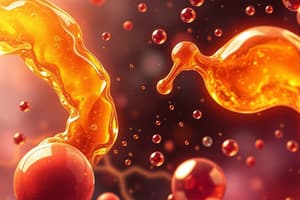Podcast
Questions and Answers
Quel type de lipide est principalement responsable du stockage d'énergie dans les animaux et les plantes?
Quel type de lipide est principalement responsable du stockage d'énergie dans les animaux et les plantes?
- Triglycérides (correct)
- Stérols
- Acides gras
- Phospholipides
Quelle est la structure caractéristique des stérols?
Quelle est la structure caractéristique des stérols?
- Une seule chaîne d'acide gras
- Groupe phosphaté
- Trois chaînes d'acides gras
- Quatre cycles carbonés fusionnés (correct)
Quel effet a la saturation des acides gras sur la fluidité de la membrane cellulaire?
Quel effet a la saturation des acides gras sur la fluidité de la membrane cellulaire?
- Elle augmente la fluidité
- Elle cause une rigidité complète
- Elle n'a pas d'effet
- Elle la Diminue (correct)
Quelle est la fonction des phospholipides dans les membranes cellulaires?
Quelle est la fonction des phospholipides dans les membranes cellulaires?
Quel type d'acide gras a au moins une double liaison dans sa chaîne carbonée?
Quel type d'acide gras a au moins une double liaison dans sa chaîne carbonée?
Quels lipides sont cruciales pour la production d'hormones stéroïdiennes?
Quels lipides sont cruciales pour la production d'hormones stéroïdiennes?
Quel processus digestif emulsionne les graisses pour leur digestion?
Quel processus digestif emulsionne les graisses pour leur digestion?
Quel est le principal avantage des lipides pour les organes internes?
Quel est le principal avantage des lipides pour les organes internes?
Flashcards
Qu'est-ce que les lipides ?
Qu'est-ce que les lipides ?
Les lipides sont un groupe diversifié de molécules organiques hydrophobes, insolubles dans l'eau. Ils sont des composants essentiels des membranes cellulaires, du stockage d'énergie et de la signalisation.
Qu'est-ce qu'un acide gras ?
Qu'est-ce qu'un acide gras ?
Les acides gras sont de longues chaînes hydrocarbonées avec un groupe carboxyle à une extrémité.
Quelle est la différence entre les acides gras saturés et insaturés ?
Quelle est la différence entre les acides gras saturés et insaturés ?
Les acides gras saturés n'ont aucune double liaison entre les atomes de carbone. Les acides gras insaturés ont une ou plusieurs doubles liaisons entre les atomes de carbone.
Qu'est-ce qu'un triglycéride ?
Qu'est-ce qu'un triglycéride ?
Signup and view all the flashcards
Qu'est-ce qu'un phospholipide ?
Qu'est-ce qu'un phospholipide ?
Signup and view all the flashcards
Qu'est-ce qu'un stérol ?
Qu'est-ce qu'un stérol ?
Signup and view all the flashcards
Quel est le rôle principal des lipides dans le stockage d'énergie ?
Quel est le rôle principal des lipides dans le stockage d'énergie ?
Signup and view all the flashcards
Quel est le rôle des lipides dans la structure des membranes ?
Quel est le rôle des lipides dans la structure des membranes ?
Signup and view all the flashcards
Study Notes
Lipids: General Characteristics
- Lipids are a diverse group of hydrophobic organic molecules, insoluble in water.
- They are crucial components of cell membranes, energy storage, and signaling.
- Key roles include acting as structural components of cell membranes, storing energy, and serving as signaling molecules.
- Common lipids include fatty acids, triglycerides, phospholipids, and sterols.
- Fatty acids are long hydrocarbon chains with a carboxyl group at one end.
Types of Lipids
- Fatty Acids:
- Saturated fatty acids have no double bonds between carbon atoms.
- Unsaturated fatty acids have one or more double bonds between carbon atoms, usually cis configurations.
- Monounsaturated fatty acids have one double bond, whereas polyunsaturated fatty acids have more than one double bond.
- Different fatty acid chains have different melting points.
- Triglycerides (or triacylglycerols):
- Composed of three fatty acids esterified to a glycerol molecule.
- Major form of energy storage in animals and plants.
- Stored in adipose tissue for long-term energy reserves.
- Phospholipids:
- Composed of a glycerol backbone, two fatty acids, and a phosphate group.
- Crucial components of cell membranes.
- Amphipathic, having both hydrophobic (fatty acid) and hydrophilic (phosphate) regions enabling them to form bilayers.
- Sterols:
- Examples include cholesterol, estrogen, testosterone.
- Four fused carbon rings structure.
- Important components of cell membranes and precursors for steroid hormones.
- Cholesterol is crucial for membrane fluidity and a precursor for various steroid hormones.
Lipid Functions
- Energy Storage:
- Triglycerides are the major energy storage form.
- Oxidation of fatty acids yields more energy per gram than carbohydrates.
- Membrane Structure:
- Phospholipids form the basic structure of cell membranes.
- Cell membrane fluidity is influenced by fatty acid saturation and cholesterol levels.
- Hormone Production:
- Steroids, derived from cholesterol, serve as hormones.
- Examples include sex hormones (estrogen, testosterone, progesterone) and adrenal cortical hormones.
- Insulation and Protection:
- Fats provide insulation against cold temperatures.
- They cushion internal organs and protect them from physical shock.
Lipid Digestion and Absorption
- Lipids are digested in the small intestine.
- Bile salts emulsify fats into smaller droplets, increasing the surface area for lipase action.
- Pancreatic lipases hydrolyze triglycerides into fatty acids and monoglycerides.
- Absorbed fatty acids and monoglycerides are re-synthesized into triglycerides and incorporated into chylomicrons.
- Chylomicrons are transported through the lymphatic system and then into the bloodstream.
Lipid Metabolism
- Fatty acid oxidation is a major metabolic pathway for energy production.
- β-oxidation involves breaking down fatty acids into acetyl-CoA molecules, which enter the citric acid cycle.
- Lipogenesis is the synthesis of fatty acids from acetyl-CoA.
- Lipid metabolism is regulated by hormones, such as insulin and glucagon.
- Dysregulation of lipid metabolism can lead to various health problems like obesity and cardiovascular disease.
Studying That Suits You
Use AI to generate personalized quizzes and flashcards to suit your learning preferences.




